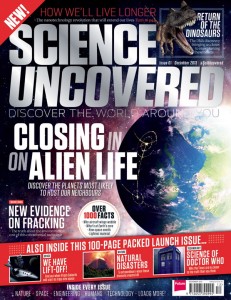Is a faster than light propulsion system actually possible? Science Uncovered investigates...

It's a fundamental feature of the Star Trek universe and similar concepts crop up in other sci-fi series. But is warp drive possible? Over to our new sister mag, Science Uncovered ...
If warp drive – or other FTL travel – were possible, it would certainly make inter-stellar space travel more convenient in the future. Take Alpha Centauri, our nearest star system. It’s 4.37 lightyears away and travelling at the current speed of Voyager 1 (17 kilometres a second) it would take approximately 67,000 years for a spaceship to reach it. If you take the star Kepler-62, now thought to be orbited by two habitable planets, it would take us more than 20,800,000 years to get there, even using today’s cutting edge propulsion technology.
Rather inconveniently, sci-fi solutions tend to break one of the main tenants of Einstein's theory of special relativity – no object can travel faster than light in space time.
But we have physicist Dr Miguel Alcubierre to thank for giving us a glimmer of hope that a warp drive may one day be propelling astronauts. He proposed a theory for how warp drive would work. It's essentially a cheat – instead of moving an object faster than the speed of light, you warp spacetime itself. He proposed that spacecraft could travel a wave of warped spacetime, while existing in a bubble of normal spacetime.
The warp drive would then work by contracting space in front of the ship, pulling it to its destination, and expanding space behind it, effectively pushing it forward.

As far fetched as all this sounds, it hasn't stopped the good people at NASA from setting the ball rolling with proof-of-concept experiments. Dr Harold "Sonny" White and his team are conducting small-scale tests on photons to see if warp drive travel could one day be possible.
Get sneak previews, exclusive competitions and details of special events each month!
The aim of their experiments is to simulate the Alcubierre drive in miniature form - by using lasers to warp spacetime by one part in 10 million. Dr White and his team are trying to slightly warp the trajectory of a photon, changing the distance it travels within a certain area then observing the change with a device called an interferometer.
These experiments are the latest stage in Dr White's work on a warp drive. In 2011 he released a paper called Warp Field Mechanics 101 , which contains an updated version of Dr Alcubierre's warp drive theory. The problem with the original design is that it required far too much energy to work. But by changing the shape of the warp drive bubble around the spacecraft to a doughnut shape, Dr White proves he could make it more energy efficient and, theoretically, more feasible.
So warp drive is still a distant dream – but it’s not time to give up hope just yet.
The first issue of SFX 's sister magazine, Science Uncovered , goes on sale on Thursday 21 November, in all good newsagents and supermarkets and in digital form. Find out more at www.science-uncovered.com and follow the team on twitter at @SciUncovered .
SFX Magazine is the world's number one sci-fi, fantasy, and horror magazine published by Future PLC. Established in 1995, SFX Magazine prides itself on writing for its fans, welcoming geeks, collectors, and aficionados into its readership for over 25 years. Covering films, TV shows, books, comics, games, merch, and more, SFX Magazine is published every month. If you love it, chances are we do too and you'll find it in SFX.


